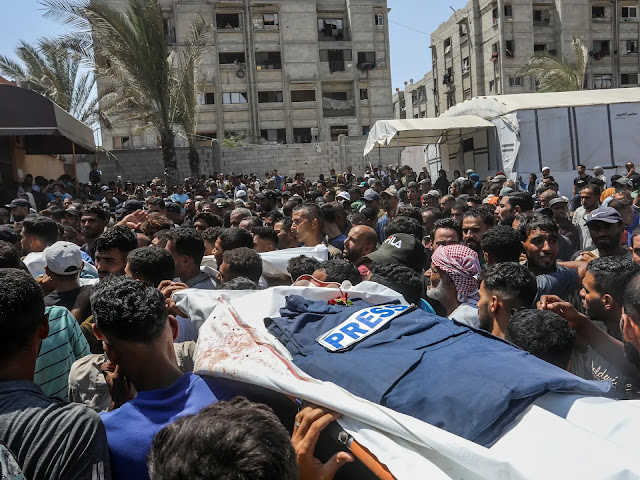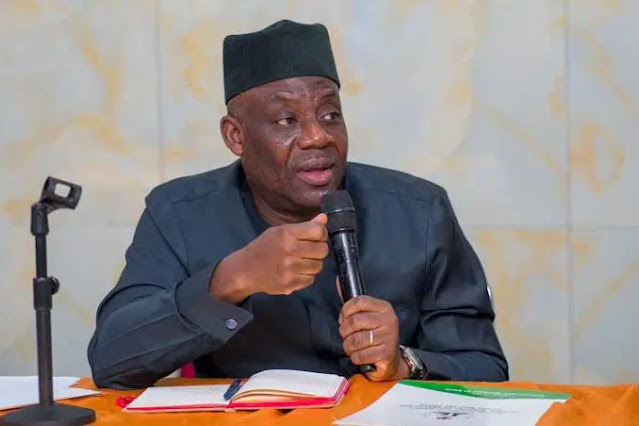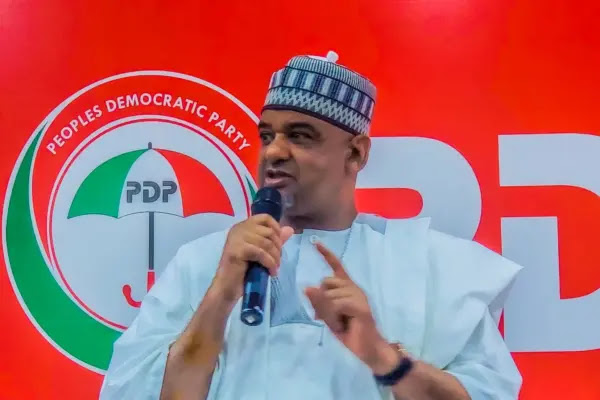On Monday, a devastating sequence of Israeli military strikes on Nasser Hospital in Khan Younis, located in southern Gaza, resulted in the deaths of at least 20 people, including five journalists, four medical workers, and a member of Gaza’s Civil Defense organization, alongside other civilians. The attack, described by observers as a “double-tap” strike—two consecutive strikes minutes apart—has drawn widespread international condemnation, reigniting debates over the protection of civilians, journalists, and medical facilities in conflict zones. The strikes targeted a hospital balcony frequently used by journalists to report on the ongoing conflict in Gaza, amplifying concerns about press freedom and potential violations of international humanitarian law. This report delves into the details of the incident, the responses from various stakeholders, and the broader implications for the Gaza conflict, press safety, and international accountability.
The Incident: A Double-Tap Strike on Nasser Hospital
The Nasser Hospital, one of the few remaining partially operational medical facilities in southern Gaza, became the epicenter of tragedy when Israeli forces launched two consecutive strikes on Monday morning. According to the Palestinian Ministry of Health, the attacks claimed at least 20 lives and left many others injured. The hospital, a critical lifeline for Gaza’s war-ravaged population, was already operating under severe strain due to ongoing hostilities, shortages of medical supplies, and the constant threat of bombardment.
Dr. Mohammad Saqer, the hospital’s spokesman and head of nursing, confirmed the grim toll, identifying the victims as including five journalists, four health workers, and a member of Gaza’s Civil Defense. The journalists killed were Mohammad Salama, a reporter for Al Jazeera; Hussam Al-Masri, a contractor for Reuters; Mariam Abu Dagga, who worked for both the Associated Press and Independent Arabic; and freelancers Moath Abu Taha and Ahmed Abu Aziz. The Civil Defense crew member killed was among those responding to the initial strike, highlighting the dangers faced by first responders in the conflict.
Eyewitness accounts and video footage from the scene paint a harrowing picture. Journalists and medical workers were documenting the aftermath of the first strike, which hit a balcony area used by media personnel for reporting, when a second explosion tore through the building minutes later. The footage shows chaos unfolding as survivors scrambled for cover amid debris and smoke. The “double-tap” nature of the attack—where a second strike targets those responding to the first—has been widely criticized as a tactic that endangers civilians, particularly first responders and journalists.
The hospital itself sustained significant damage, further crippling its ability to provide care. Doctors Without Borders (Médecins Sans Frontières, or MSF), which has staff at Nasser Hospital, described the attack as a “direct assault” on the only partially functioning public hospital in southern Gaza. MSF reported that its staff were forced to shelter inside the facility as the strikes continued, underscoring the precarious conditions under which medical personnel operate in the region.
Israeli Military’s Response: Admission and Justification
The Israel Defense Forces (IDF) acknowledged responsibility for the strikes but maintained that civilians were not intentionally targeted. IDF spokesman Brig. Gen. Effie Defrin described the operating environment in Gaza as an “extremely complex reality,” accusing Hamas of exploiting civilian infrastructure, including hospitals, for military purposes. “The IDF does not intentionally target civilians,” Defrin stated in a press briefing, emphasizing that the military takes precautions to minimize harm to non-combatants.
However, an Israeli security official, speaking anonymously to local media, provided a more detailed account of the decision-making process behind the strikes. According to the official, IDF forces had identified a camera on the hospital’s roof, which they believed was being used by Hamas for surveillance purposes. Authorization was given to neutralize the camera, resulting in the firing of two tank shells. The first shell struck the camera position, while the second hit first responders who had rushed to the scene, including journalists and medical workers. This revelation has fueled accusations that the IDF failed to adequately assess the risk to civilians before launching the strikes.
Israeli Prime Minister Benjamin Netanyahu addressed the incident in a public statement, calling it a “tragic mishap” and pledging a thorough investigation. “Israel values the work of journalists, medical staff, and all civilians,” Netanyahu said. “The military authorities are conducting a thorough investigation to understand the circumstances of this incident and to ensure it does not happen again.” The promise of an investigation, however, has done little to quell international outrage, with critics arguing that such inquiries rarely lead to accountability.
International Condemnation and Calls for Accountability
The strikes on Nasser Hospital have sparked a wave of condemnation from international organizations, governments, and advocacy groups. The United Nations Secretary-General, António Guterres, issued a strong statement denouncing the killings and urging that civilians, journalists, and medical personnel be “protected at all times.” Guterres emphasized the sanctity of hospitals under international humanitarian law, which designates medical facilities as protected spaces during armed conflicts.
The Committee to Protect Journalists (CPJ), a global advocacy organization, accused Israel of committing “unlawful killings” and potentially engaging in “war crimes.” In a statement, CPJ’s CEO, Jodie Ginsberg, described the attack as a “deliberate and devastating blow to press freedom in Gaza.” The organization noted that since the onset of the Gaza war, at least 192 journalists have been killed, making it one of the deadliest conflicts for media workers in recent history. The CPJ called for an independent investigation into the strikes and urged the international community to hold Israel accountable for violations of international law.
The Foreign Press Association (FPA) in Israel and the Palestinian Territories labeled the attack “among the deadliest Israeli attacks on journalists working for international media since the Gaza war began.” The FPA described the incident as a “watershed moment” for press safety, highlighting the growing risks faced by journalists operating in conflict zones. The organization called on Israel to provide clear assurances that media workers would not be targeted in future operations.
The Palestinian Journalists Syndicate went further, describing the attack as a “heinous massacre” and accusing Israeli forces of deliberately targeting media workers to suppress reporting on the Gaza conflict. The syndicate’s statement pointed to a pattern of attacks on journalists, noting that the deaths of Salama, Al-Masri, Abu Dagga, Abu Taha, and Abu Aziz added to an alarming tally of media casualties.
Doctors Without Borders echoed these concerns, emphasizing the impact of the strikes on Gaza’s already fragile healthcare system. “The targeting of Nasser Hospital is a direct assault on the ability of medical workers to provide lifesaving care,” an MSF spokesperson said. The organization called for an immediate ceasefire and the protection of medical facilities, warning that further attacks could lead to the complete collapse of Gaza’s healthcare infrastructure.
The Broader Context: Gaza’s War and the Toll on Journalists
The strikes on Nasser Hospital come amid a broader escalation of violence in the Gaza Strip, where the ongoing conflict between Israel and Hamas has claimed thousands of lives and displaced millions. The war, which began with Hamas’s attack on southern Israel on October 7, 2023, has seen relentless Israeli airstrikes and ground operations aimed at dismantling the group’s military capabilities. Hamas, in turn, has been accused of using civilian infrastructure, including hospitals and schools, as shields for its operations, a claim that complicates the application of international humanitarian law.
Hospitals in Gaza have been repeatedly caught in the crossfire, with Nasser Hospital among the few still able to provide limited services. The facility has been a focal point for both medical care and media coverage, as journalists use its premises to report on the human toll of the conflict. The targeting of the hospital’s balcony, a known gathering point for media workers, has raised questions about whether the strike was intended to disrupt reporting on the war.
The deaths of the five journalists have brought renewed attention to the dangers faced by media workers in Gaza. According to the CPJ, the 192 journalists killed since the start of the war represent a staggering loss for the profession. These figures include both Palestinian and international journalists, many of whom were working for major news outlets like Al Jazeera, Reuters, and the Associated Press. The CPJ has documented a pattern of attacks on journalists, including direct strikes, arrests, and restrictions on movement, which have severely curtailed press freedom in the region.
The concept of a “double-tap” strike, while not unique to the Gaza conflict, has drawn particular scrutiny in this case. Such strikes are designed to maximize damage by targeting first responders who rush to aid victims of an initial attack. Critics argue that this tactic violates international humanitarian law, which prohibits attacks that disproportionately harm civilians. The IDF’s admission that the second shell struck first responders has bolstered these criticisms, with human rights groups calling for an investigation into whether the strike constitutes a war crime.
Legal and Ethical Implications
The targeting of a hospital, even if allegedly used for military purposes, raises complex questions under international humanitarian law (IHL). The Geneva Conventions, which govern the conduct of armed conflicts, explicitly protect medical facilities, personnel, and civilians, including journalists. Hospitals lose their protected status only if they are used for acts harmful to the enemy, such as hosting military operations. However, any attack on a hospital must adhere to the principles of distinction, proportionality, and necessity, ensuring that civilian harm is minimized.
The IDF’s claim that a camera on the hospital roof was being used by Hamas for surveillance purposes suggests an attempt to justify the strike under IHL. However, legal experts argue that the presence of a camera does not necessarily constitute a military use of the hospital, particularly if it was being used by journalists for reporting. Furthermore, the decision to fire a second shell at first responders raises serious questions about proportionality and the IDF’s adherence to IHL.
The CPJ and other organizations have called for an independent investigation to determine whether the strike violated international law. Such an investigation would need to examine the IDF’s intelligence, decision-making process, and the measures taken to avoid civilian casualties. The promise of an internal IDF investigation, as announced by Netanyahu, has been met with skepticism, as previous inquiries into civilian deaths have often been criticized for lacking transparency and accountability.
The Human Cost: Stories of the Victims
The loss of life at Nasser Hospital has left a profound impact on the families, colleagues, and communities of the victims. The five journalists killed were among Gaza’s most dedicated media professionals, risking their lives to document the conflict and its impact on civilians.
Mohammad Salama was a veteran reporter for Al Jazeera, known for his fearless coverage of the Gaza war. His colleagues described him as a mentor to younger journalists, with a deep commitment to telling the stories of ordinary Palestinians.
Hussam Al-Masri, a contractor for Reuters, was a skilled videographer whose work brought the realities of the conflict to a global audience. His death has left a void in Reuters’ Gaza coverage.
Mariam Abu Dagga, who worked for both the Associated Press and Independent Arabic, was a rising star in journalism, known for her nuanced reporting on the human cost of the war.
Moath Abu Taha and Ahmed Abu Aziz, both freelancers, were part of a growing community of independent journalists in Gaza, often working under precarious conditions to share stories that might otherwise go untold.
The four medical workers and the Civil Defense crew member killed were equally dedicated to their roles. Dr. Saqer, the hospital spokesman, described the medical staff as “heroes” who continued to work despite the constant threat of violence. The Civil Defense worker, whose identity has not been publicly released, was among the first to respond to the initial strike, only to lose their life in the second explosion.
Regional and Global Reactions
The attack on Nasser Hospital has reverberated beyond Gaza, prompting reactions from governments, NGOs, and civil society groups worldwide. The European Union issued a statement condemning the strikes and calling for the protection of civilians and journalists. Several Arab states, including Egypt and Jordan, denounced the attack as a violation of international law, urging the United Nations to take action.
In the United States, the Biden administration expressed concern over the incident but stopped short of condemning Israel outright. A State Department spokesperson reiterated the U.S.’s support for Israel’s right to defend itself while emphasizing the need to protect civilians and journalists. The cautious response reflects the delicate balance the U.S. maintains in its relationship with Israel amid growing domestic and international pressure to address the humanitarian crisis in Gaza.
Human rights organizations, including Amnesty International and Human Rights Watch, have called for an independent investigation and accountability for those responsible. These groups have also urged the International Criminal Court (ICC) to expedite its ongoing investigation into alleged war crimes in the Israel-Palestine conflict.
The Impact on Gaza’s Healthcare System
The strikes on Nasser Hospital have further strained Gaza’s already collapsing healthcare system. With most hospitals in the region either destroyed or operating at minimal capacity, Nasser Hospital was a critical hub for treating the wounded and providing essential medical services. The damage to the facility, combined with the loss of medical staff, has left thousands of patients without access to care.
MSF reported that the hospital’s emergency department was overwhelmed in the aftermath of the strikes, with staff struggling to treat the injured while under constant threat of further attacks. The organization warned that the loss of Nasser Hospital as a functional medical facility could have catastrophic consequences for Gaza’s population, particularly as winter approaches and humanitarian conditions deteriorate.
The targeting of medical facilities in Gaza has been a recurring issue throughout the conflict. According to the World Health Organization (WHO), more than 70% of Gaza’s hospitals have been damaged or destroyed since the war began, with hundreds of medical workers killed or injured. The WHO has called for an immediate ceasefire and the establishment of humanitarian corridors to allow medical supplies and personnel to reach those in need.
The Role of Journalism in Conflict Zones
The deaths of the five journalists at Nasser Hospital underscore the critical role of journalism in documenting conflicts and holding parties accountable. Journalists in Gaza operate under extreme conditions, facing not only the physical dangers of war but also restrictions on movement, access to information, and communication networks. The targeting of media workers, whether intentional or not, has a chilling effect on press freedom and the ability to report on the war’s impact on civilians.
The FPA and CPJ have called for greater protections for journalists in conflict zones, including the establishment of safe zones for reporting and international mechanisms to investigate attacks on media workers. These organizations argue that the loss of journalists not only deprives the world of critical information but also undermines efforts to document potential war crimes and human rights abuses.
Looking Forward: Accountability and Ceasefire Calls
The attack on Nasser Hospital has intensified calls for a ceasefire in Gaza, with many arguing that the escalating violence is unsustainable and devastating for civilians. The international community faces mounting pressure to broker a resolution to the conflict, which has already claimed tens of thousands of lives and displaced nearly the entire population of Gaza.
The promise of an IDF investigation into the strikes has been met with skepticism, given the lack of accountability in previous incidents involving civilian deaths. Human rights groups and international organizations are pushing for an independent probe, potentially led by the United Nations or the ICC, to ensure transparency and justice.
For the families of the victims, the loss is immeasurable. The journalists, medical workers, and first responders killed at Nasser Hospital were not only professionals but also individuals with families, dreams, and a commitment to serving their communities. Their deaths serve as a stark reminder of the human cost of the Gaza conflict and the urgent need for a resolution that prioritizes the protection of civilians and the restoration of peace.
Conclusion
The Israeli strikes on Nasser Hospital in Khan Younis have sent shockwaves through the international community, highlighting the devastating toll of the Gaza conflict on civilians, journalists, and medical workers. The “double-tap” attack, which killed 20 people, including five journalists, has been condemned as a potential war crime and a direct assault on press freedom and humanitarian principles. As the world grapples with the fallout of this incident, questions of accountability, compliance with international law, and the protection of civilians remain at the forefront. The tragedy at Nasser Hospital is a sobering reminder of the urgent need for a ceasefire, independent investigations, and a renewed commitment to safeguarding those who risk their lives to heal, report, and serve in times of war.






